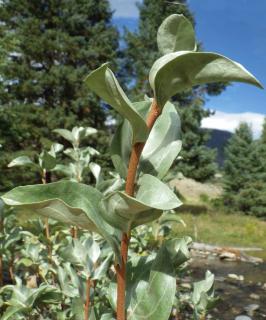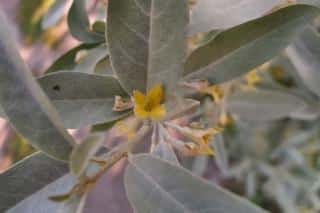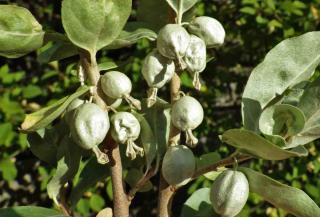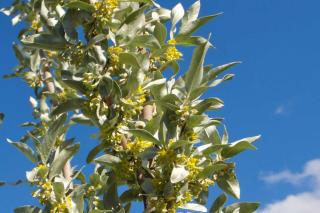

Silverberry is a very beautiful ornamental evergreen shrub.
Key silverberry facts
Name – Elaeagnus x commutata
Family – Elaeagnaceae
Type – shrub
Height – 6 to 10 feet (2 to 3 meters) depending on the variety
Exposure – full sun, part sun
Soil – ordinary
Foliage – evergreen – Flowering – Spring
Care, planting and annual pruning help enhance the growth of your silverberry plant.
 Silverberry is best planted in fall, but it copes perfectly with being planted all year round if purchased potted.
Silverberry is best planted in fall, but it copes perfectly with being planted all year round if purchased potted.
This shrub resists harsh conditions well, making it ideal for coastal gardens.
To make a hedge, space trunks around 3 feet (1 meter) apart.
 Prune with the goal to increase the number of branches. This will result in your shrubs or hedges being more opaque. In order to succeed, prune the shrubs lightly over the first few years, cutting back about ⅓ of the previous year’s growth.
Prune with the goal to increase the number of branches. This will result in your shrubs or hedges being more opaque. In order to succeed, prune the shrubs lightly over the first few years, cutting back about ⅓ of the previous year’s growth.
Pruning time for silverberry is the beginning of spring or in fall.
Silverberry shrubs grow back after all sorts of pruning, even if these were drastic.
They can thus be given different shapes, such as a big ball or other, without hindering their development.
It’s native to the Americas and is a perfect alternative to invasive Russian Olive.
Being extremely hardy and very beautiful with its silver-gold hues, silverberry is making a comeback among the favorite plants in our gardens.
Evergreen varieties reflect light towards flower beds and lighten up hedges all year round.
 In spring, its discrete and soft blooming attracts bees with a delicate fragrance. The berries, when fully ripe, can be harvested to prepare silverberry jam.
In spring, its discrete and soft blooming attracts bees with a delicate fragrance. The berries, when fully ripe, can be harvested to prepare silverberry jam.
An interesting species which belongs to the same Elaeagnus genus is E. angustifolia, also called Russian olive tree. However, if you’re not in its native zone, it’s better not to plant that particular species.
Another species with appealing yellow-mottled leaves is Eleagnus pungens maculata.
Read more on shrubs:
 Other interesting hedge shrubs: strawberry tree, wild privet, weigela, cypress, camellia, photinia, flowering currant…
Other interesting hedge shrubs: strawberry tree, wild privet, weigela, cypress, camellia, photinia, flowering currant…
Elaeagnus usually doesn’t do well in very wet ground. Avoid waterlogged soil and stagnant water or your plant will dwindle away.
Ok moved it 10 to the other side of the yard.
Umm they have bird netting in the store i can use it instead of fishing line.
Might work on the cats in the flower bed after it stops the birds. Dang cat only thing I have not tried is the net and poison but thats another issue.
Good ideas, I got and owl there, they sit on it’s movable head.
They don’t roost there its a waiting station for the feeder which is now empty I will move it shortly. Droppings? Notice!! You ever see pictures of cliffs where birds roost. That’s about the same look here, there is new growth on places the birds don’t go through it. So you might have the reason. I never thought of that.
Ha so they got used to the owl already…
Since the birds flitter to and fro, that also inhibits leaf growth: repeated light stimulation (wingtips, wind) signals the bush that “this space is occupied” so it doesn’t try to grow leaves there anymore. The same thing happens when you look at a tree crown in a forest from below: the branches of two neighboring trees never grow into each other, they always stop just short.This is why a “corridor” is forming in your silverberry bush.
For sure, your best call now is to hope the birds move out. Stop filling the feeder (birds don’t need any help in summer, it makes them dependent), relocate it to the other side of the yard. Make the bush more inhospitable by crisscrossing a very thin fishing line among the branches: the bird’s flight will be hampered by something they can’t see and they won’t want to get tangled up (remove in a month’s time). And since the soil is accordingly loaded with nitrogen, mulch with wood chips: during the initial break-down phase, healthy fungus develop that require a lot of nitrogen, so you’ll be solving that problem and preparing the bush for a strong comeback next fall.
Thank you. I have been watering even the trees but no help.
The Bush had some branches die off last year or so ago too. These areas were growing back but have started dying again.
I’ve been thinking and there are about 100 birds that make 3 or 4 trips a day through the bush. It started dying where they go in and it looks like now where they go out of it. And it appears to be a direct path to the bird feeder which is closer now since the bush had grown. I think I will move the feeder. But why the bottom branches are dying I’m still not sure of? I’m in a part of Texas that a disease kills pitosporums in 2 years, I lost 2 of those before I found that out. But if a disease is doing this then the silverberries in the whole yard would be dying. I’m going to try moving the feeder. I’ve scared so many sparrows out of the bush you couldn’t hit them all with a double barrel shotgun filled with birdshot.
Hi Keith, thanks for your answer; I have learned of cases where birds would kill trees due to excess manure. If a hundred birds are roosting in that single bush, excess nitrogen might “burn” the roots, all the more so that heat increases water intake. Do you notice a lot of droppings around the tree? That might explain the new growth dying off. Maybe a bogus owl in the bush might scare them off? Alternately, perhaps you could prune the dying branches back and lighten up the tree to reduce the cover it provides the birds; they might choose to move out if they feel too exposed.
My silver berry is dying off branches for some reason? It’s been in the yard for years it’s about 6 feet tall and wide but once solid bush is dropping new growth, and old in the center of the bush and were it gets most of the heat and direct texas sun. But the new growth was on the bottom in the shaded area. I’m not talking 6 to 10 inche pieces but rather 4 to 6 foot long Branches are drying up. No matter how much water I give it. Yes its drained well. It’s got two trees and 2 hawthorn bushes competing for the same water. The silverberry 5 feet from it and the ones on the other side of the driveway are fine, the one in back where it’s in soil that is marshy when I water or it rains is fine. That ground drys out in 30 minutes in this heat, so I am at a loss as to why this one is dying. Unless the birds are killing it?
Hi Keith, as you say, the heat wave is extreme this year. It might be that this particular tree, already being stressed out from the heat, is brought to its knees by its neighbors (trees aren’t always nice to each other). Even if you’ve started watering, it takes time for the coping to reverse. I would suggest finding something to make a thick layer of mulch, even up to 8-10 inches thick, like dried leaves or compost, and spread across the entire drip line of the tree (that’s the shade the tree drops to the ground at midday); this should help save water from evaporation just where all the roots are. It’ll take a lot of water at the beginning, though. I don’t think the birds can damage the tree, picking fruits isn’t a problem. If the heat wave keeps at it, maybe pull up a sun-cutting netting above the tree to lessen direct sun, at 6 feet tall it shouldn’t be too much of a hassle. In the end, it’ll bounce back once balance is restored.